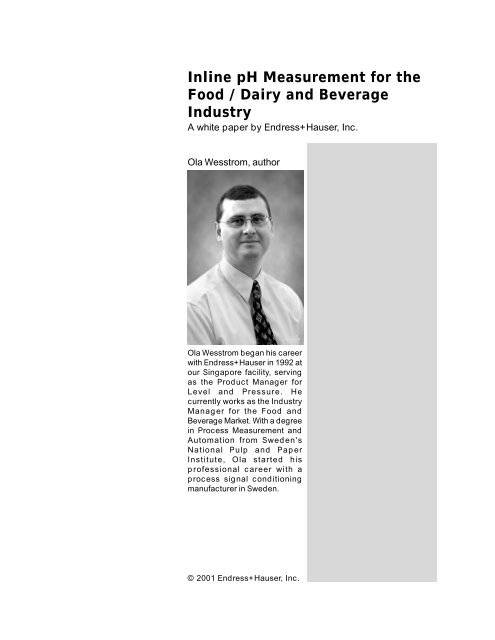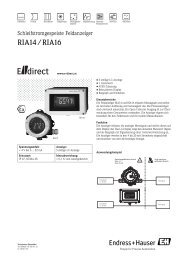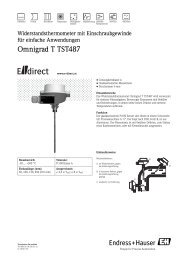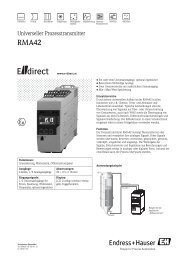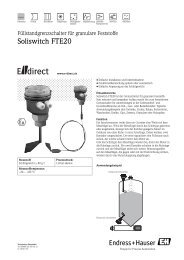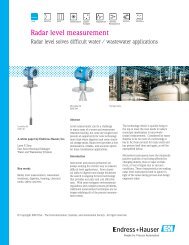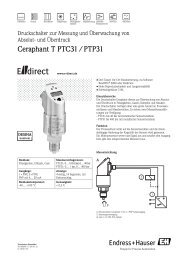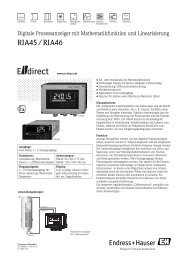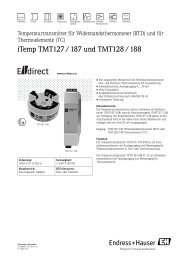Inline pH Measurement for the Food / Dairy and ... - Endress+Hauser
Inline pH Measurement for the Food / Dairy and ... - Endress+Hauser
Inline pH Measurement for the Food / Dairy and ... - Endress+Hauser
Create successful ePaper yourself
Turn your PDF publications into a flip-book with our unique Google optimized e-Paper software.
<strong>Inline</strong> <strong>pH</strong> <strong>Measurement</strong> <strong>for</strong> <strong>the</strong><br />
<strong>Food</strong> / <strong>Dairy</strong> <strong>and</strong> Beverage<br />
Industry<br />
A white paper by <strong>Endress+Hauser</strong>, Inc.<br />
Ola Wesstrom, author<br />
Ola Wesstrom began his career<br />
with <strong>Endress+Hauser</strong> in 1992 at<br />
our Singapore facility, serving<br />
as <strong>the</strong> Product Manager <strong>for</strong><br />
Level <strong>and</strong> Pressure. He<br />
currently works as <strong>the</strong> Industry<br />
Manager <strong>for</strong> <strong>the</strong> <strong>Food</strong> <strong>and</strong><br />
Beverage Market. With a degree<br />
in Process <strong>Measurement</strong> <strong>and</strong><br />
Automation from Sweden's<br />
National Pulp <strong>and</strong> Paper<br />
Institute, Ola started his<br />
professional career with a<br />
process signal conditioning<br />
manufacturer in Sweden.<br />
© 2001 <strong>Endress+Hauser</strong>, Inc.
The Role of <strong>pH</strong> Control<br />
The ability to monitor <strong>and</strong> control <strong>pH</strong> has important applications<br />
in many food processing operations. <strong>Food</strong> quality <strong>and</strong><br />
freshness are often directly related to <strong>pH</strong>. sanitary procedures<br />
such as chilling, cleaning, <strong>and</strong> disinfecting control spoilage<br />
(souring) of dairy, meat, <strong>and</strong> o<strong>the</strong>r food products.<br />
However, <strong>pH</strong><br />
measurement is<br />
a tool to ensure<br />
that freshness<br />
<strong>and</strong> processing<br />
are optimized.<br />
Some of <strong>the</strong><br />
food products<br />
where <strong>pH</strong> is<br />
important<br />
include yogurt,<br />
cheese, <strong>and</strong><br />
fruit <strong>and</strong> vegetable juices, along with sauces, purees, <strong>and</strong><br />
pastes, <strong>and</strong> value-added condiments such as taco <strong>and</strong><br />
spaghetti sauces. Maintaining <strong>the</strong> proper <strong>pH</strong> levels in <strong>the</strong>se<br />
foods is important <strong>for</strong> food safety, as well as quality. FDA<br />
regulations (CFR 21-114) govern <strong>the</strong><br />
manufacture of low-acid foods that<br />
have been naturally or artificially<br />
acidified to a <strong>pH</strong> of 4.6 or lower to<br />
inhibit <strong>the</strong> growth of C. Botulinum,<br />
a bacteria that creates <strong>the</strong> exotoxin<br />
responsible <strong>for</strong> deadly botulism.<br />
The regulations specify <strong>the</strong> manner <strong>and</strong> frequency <strong>for</strong> measuring<br />
<strong>and</strong> documenting <strong>the</strong> <strong>pH</strong> of <strong>the</strong>se foods during manufacturing.<br />
It is also important to measure <strong>and</strong> control <strong>pH</strong> because taste<br />
<strong>and</strong> product qualities are often closely related to <strong>pH</strong>. An<br />
example exists in <strong>the</strong> incubation of yogurt. If <strong>the</strong> incubation is<br />
not stopped at <strong>the</strong> right <strong>pH</strong> level, <strong>the</strong> product taste is directly<br />
affected.<br />
Controlling <strong>pH</strong> Today<br />
Conventional lab measurement (manual sampling) is <strong>the</strong> most<br />
common method of monitoring <strong>the</strong> <strong>pH</strong> of a process <strong>and</strong><br />
ensuring compliance to FDA regulations (CFR 21-114). Manual<br />
sampling is time consuming <strong>and</strong> subject to sample<br />
contamination. Even small changes in temperature can result<br />
in misleading measurement results. Because of <strong>the</strong>se issues,<br />
most <strong>pH</strong> measurements are taken on an infrequent basis - at<br />
intervals ranging from 5 minutes to several hours. This makes<br />
tight process control difficult to achieve. In addition, infrequent<br />
sampling could potentially result in inconsistent product quality,<br />
or a waste of product, additives, <strong>and</strong> preservatives.<br />
1
2<br />
Manual sampling is, however,<br />
commonly accepted in <strong>the</strong><br />
industry <strong>and</strong> operators trust <strong>the</strong><br />
measurements.<br />
In-line Continuous <strong>pH</strong> <strong>Measurement</strong> vs. Manual<br />
Lab Testing<br />
To illustrate some issues with manual sampling, measurements<br />
taken manually in a cheese sauce application were plotted on<br />
a graph with in-line measurements.All of <strong>the</strong> manual sampling<br />
measurements were taken by <strong>the</strong> same operator using <strong>the</strong> same<br />
sensor.<br />
Clearly, <strong>the</strong> manual measurements have much greater variation,<br />
even though <strong>the</strong> same person was doing <strong>the</strong> measurements<br />
with <strong>the</strong> same sensor. The in-line measurement not only provides<br />
less variation in <strong>the</strong> measurement, but <strong>the</strong> benefits of<br />
continuous measurement. In-line continuous measurements<br />
provide tighter control <strong>and</strong> faster response to changes, while<br />
also helping reduce labor costs. However, conventional glass<br />
sensors are generally not accepted in food processing<br />
applications because of concerns about glass breakage directly<br />
in <strong>the</strong> process stream.
Non-glass <strong>pH</strong> Electrode (IsFET)<br />
The liability involved simply does not justify using in-line glass<br />
<strong>pH</strong> sensors. In response to this concern, non-glass <strong>pH</strong> probes<br />
based on IsFET technology have been commercially available<br />
<strong>for</strong> in-line use. However, <strong>the</strong>se probes are sensitive to extreme<br />
<strong>pH</strong> conditions encountered during normal CIP operations. In<br />
particular, exposure to caustic materials at elevated<br />
temperatures significantly reduces <strong>the</strong> useful life of <strong>the</strong>se <strong>pH</strong><br />
sensors. To overcome this problem, <strong>Endress+Hauser</strong> has<br />
developed <strong>the</strong> CPS 401, a <strong>pH</strong> sensor based on IsFET<br />
technology that can be retracted during CIP operations. The<br />
sensor itself can be automatically cleaned while it is retracted.<br />
There<strong>for</strong>e, this new probe offers an excellent solution <strong>for</strong> inline<br />
<strong>pH</strong> measurement.<br />
The mechanical construction of this probe also meets <strong>the</strong><br />
rigorous process conditions in food applications such as<br />
changing temperatures, pressures, <strong>and</strong> <strong>pH</strong> values. As a<br />
preferred sealing technology, EPDM <strong>for</strong>m seals are used to<br />
hold <strong>the</strong> <strong>pH</strong> sensitive IsFET sensor element in place. This<br />
electronic board contains all necessary sensor connections,<br />
<strong>and</strong> a temperature sensor <strong>for</strong> temperature compensation. To<br />
ensure food safety, a sensor behind <strong>the</strong> EPDM seal detects<br />
moisture inside <strong>the</strong> sensor. The sensor can immediately be<br />
retracted if <strong>the</strong> seal is compromised.<br />
Ano<strong>the</strong>r critical requirement in food applications is fast<br />
response time. To achieve this, <strong>the</strong> reference junction's design<br />
is key. In <strong>the</strong> <strong>Endress+Hauser</strong> probe a fine structured ceramic<br />
junction minimizes memory<br />
effects due to coating. This<br />
allows <strong>for</strong> response times of<br />
a few seconds <strong>for</strong> tight<br />
process control.<br />
A temperature sensor<br />
integrated in <strong>the</strong> front part of<br />
<strong>the</strong> sensor body is used <strong>for</strong><br />
temperature compensation<br />
of <strong>the</strong> measurement. It is<br />
important to avoid errors<br />
from temperature effects in<br />
CIP applications with hot<br />
process phases. The<br />
sensor's plastic construction<br />
causes an insulation effect<br />
that will slow down <strong>the</strong><br />
temperature compensation.<br />
By placing <strong>the</strong> temperature<br />
sensor in <strong>the</strong> very front tip of<br />
<strong>the</strong> IsFET sensor, this effect<br />
is minimized.<br />
3
4<br />
Per<strong>for</strong>mance Comparable to Liquid-filled Glass<br />
Sensors<br />
In order to prove this new sensor's capabilities,<br />
testing occurred in-line in series with a liquid-filled<br />
glass <strong>pH</strong> sensor. The liquid filled glass <strong>pH</strong> sensor<br />
was chosen because this technology provides <strong>the</strong><br />
fastest response time available today. In addition,<br />
it is considered <strong>the</strong> most accurate. The test was<br />
per<strong>for</strong>med in a number of different media, <strong>and</strong> <strong>the</strong><br />
results were very consistent. The IsFET was<br />
comparable to <strong>the</strong> glass sensor, responding to <strong>pH</strong><br />
changes within one to three seconds.<br />
The graph shows <strong>the</strong> per<strong>for</strong>mance of an IsFET non-glass <strong>pH</strong><br />
sensor used to monitor <strong>the</strong> fermentation of yogurt. It is again<br />
compared to a liquid-filled glass <strong>pH</strong> electrode, which is<br />
considered <strong>the</strong> most accurate means of inline<br />
<strong>pH</strong> measurement. It can be seen that<br />
<strong>the</strong> IsFET sensor provides a measurement<br />
comparable to that of a high per<strong>for</strong>mance<br />
liquid-filled glass <strong>pH</strong> sensor. The control of<br />
<strong>the</strong> fermentation process is not only critical<br />
to <strong>the</strong> quality of <strong>the</strong> product, but can also<br />
be a tool to plan <strong>and</strong> manage downstream<br />
processing or packaging.<br />
The sensor is constructed of FDA Generally<br />
Recognized as Safe (GRAS) <strong>and</strong> 3-A listed<br />
materials such as virgin PEEK. The material<br />
is virtually unbreakable <strong>and</strong> withst<strong>and</strong>s<br />
h<strong>and</strong>ling without damage. The European<br />
Hygienic Equipment Design Group (EHEDG)<br />
offers st<strong>and</strong>ardized tests to prove <strong>the</strong><br />
cleanability of sensors <strong>and</strong> transmitters <strong>for</strong>
<strong>the</strong> food, beverage, <strong>and</strong> pharmaceutical industry. The<br />
construction shown has passed EHEDG's tests <strong>for</strong> clean-ability<br />
as well as <strong>the</strong> device's ability to be sterilized. The CPS 401<br />
sensor cable is fitted with a watertight connector that simplifies<br />
sensor replacement <strong>and</strong> protects <strong>the</strong> sensor, ensuring <strong>the</strong> longterm<br />
integrity of <strong>the</strong> seal, even when <strong>the</strong> new sensors are<br />
installed.<br />
Complete System Solution<br />
The IsFET sensor can be universally applied with an in-line,<br />
removable Tri-clover connection, or in conjunction with a<br />
retractable probe holder. The retractable probe holder is<br />
preferred because <strong>the</strong> probe can be retracted during CIP <strong>and</strong><br />
kept wet during longer process shutdowns. The basic purpose<br />
of a retractable holder is to access <strong>the</strong> sensor without opening<br />
<strong>the</strong> pipe system <strong>and</strong> disassembling <strong>the</strong> sensor <strong>for</strong> cleaning<br />
<strong>and</strong> calibration. All <strong>pH</strong> sensors must be cleaned <strong>and</strong> calibrated<br />
regularly to ensure proper functioning. <strong>Endress+Hauser</strong>'s<br />
retractable holders meet sanitary requirements, such as surface<br />
finish <strong>and</strong> cleanability. They also meet 3-A sanitary st<strong>and</strong>ards.<br />
To complete <strong>the</strong> in-line <strong>pH</strong> measurement solution,<br />
<strong>Endress+Hauser</strong> offers a basic transmitter or a fully automated<br />
cleaning <strong>and</strong> calibration system.<br />
The transmitter is easy to setup via a menu-driven interface.<br />
Output <strong>for</strong> control or limit can be assigned <strong>for</strong> specific<br />
applications. The automatic calibration <strong>and</strong> cleaning system<br />
makes maintenance very user friendly. Operators simply need<br />
to keep <strong>the</strong> buffer <strong>and</strong> cleaning solutions replenished. Fully<br />
automated <strong>pH</strong> measuring systems offer a st<strong>and</strong>-alone solution<br />
with microprocessor-based programming. The system can be<br />
programmed to retract <strong>the</strong> sensor <strong>for</strong> cleaning <strong>and</strong> calibration<br />
on a time-based interval or at a predetermined <strong>pH</strong> value. An<br />
external input is also available to allow retraction of <strong>the</strong> sensor<br />
on operator comm<strong>and</strong>, or from<br />
an external control system.<br />
Maintenance steps such as<br />
cleaning, calibration, <strong>and</strong><br />
replacement can be per<strong>for</strong>med<br />
during process shutdown, or<br />
during <strong>the</strong> CIP cycle when a<br />
retractable holder is used. For<br />
automatic synchronization to <strong>the</strong><br />
process, <strong>the</strong> retraction of <strong>the</strong><br />
sensor can be accomplished<br />
manually, or via pneumatic<br />
signals from <strong>the</strong> automatic<br />
cleaning <strong>and</strong> calibration system.<br />
Replaceable seals are used to<br />
seal <strong>the</strong> process towards <strong>the</strong><br />
moving electrode guide <strong>and</strong><br />
isolate <strong>the</strong> electrode. In a fully<br />
5
6<br />
retracted position, <strong>the</strong> electrode resides in a separate cleaning<br />
chamber. Cleaning or calibration liquids are connected to <strong>the</strong><br />
chamber flush ports. These defined <strong>and</strong> repeatable conditions<br />
achieve better cleaning <strong>and</strong> calibration results. The lifetime of<br />
<strong>the</strong> <strong>pH</strong> electrode is extended since no manual interaction is<br />
necessary. The overall reliability <strong>and</strong> accuracy of <strong>the</strong> <strong>pH</strong><br />
measurement point is optimized with an automated retractable<br />
system <strong>for</strong> better process control.<br />
Potential Cost Savings<br />
It is difficult to put a dollar value on <strong>the</strong> benefits of in-line <strong>pH</strong><br />
measurement. Each application must be evaluated on its<br />
investment return. However, this solution will offer substantial<br />
product quality improvements <strong>and</strong> a reduction in operating<br />
costs in many applications. The following are just a few<br />
examples of areas where significant improvements can be<br />
achieved.<br />
Example: Cheese manufacturing<br />
With a production rate of 50-pounds per minute, a 30-minute<br />
lab sample interval could equal a loss of 1,500 pounds of<br />
product worth approximately $1,500 to $2,500 if <strong>the</strong> <strong>pH</strong> is not<br />
within <strong>the</strong> permitted values. In-line measurement could eliminate<br />
<strong>the</strong>se costs.<br />
Example: Fermentation control<br />
To allow preparation of a packaging line or downstream<br />
processing, <strong>pH</strong> control is critical in <strong>the</strong> prediction of<br />
fermentation end points. Product left too long in a fermentor<br />
can have a detrimental effect on <strong>the</strong> end product. These<br />
concerns can be eliminated with in-line <strong>pH</strong> measurement.<br />
Example: Starter culture <strong>for</strong> cheese, sour cream, <strong>and</strong> yogurt<br />
A <strong>pH</strong> reading is used to quench (stop growth) at <strong>the</strong> desired<br />
<strong>pH</strong>, allowing <strong>the</strong> next batch to start. In-line <strong>pH</strong> measurement<br />
offers a potential <strong>for</strong> one to five additional batches per week.<br />
This could translate into an additional production yield totaling<br />
$10,000 to $150,000.
Summary<br />
It is a big step <strong>for</strong> most industrial processing operations to<br />
stray from <strong>the</strong> conventional <strong>and</strong> well-accepted manual method<br />
of <strong>pH</strong> control. However, like many aspects of business today,<br />
change is unavoidable. Individuals should proactively<br />
participate <strong>and</strong> take actions that effectuate positive changes<br />
in plant operations.<br />
With <strong>pH</strong> measurement in regulated applications, several<br />
groups of people need to be involved to implement <strong>the</strong> change<br />
in a beneficial way.<br />
• Process engineers need to design <strong>the</strong> system to work around<br />
<strong>the</strong> in-line measurement.<br />
• Operations <strong>and</strong> quality managers need to underst<strong>and</strong> <strong>the</strong><br />
benefits.<br />
• The sanitation team must feel com<strong>for</strong>table with <strong>the</strong> device's<br />
cleanability.<br />
• The lab team must be certain that <strong>the</strong> measurement data can<br />
be used to make process improvements.<br />
When applied correctly, <strong>the</strong> non-glass IsFET <strong>pH</strong> sensor will<br />
enable better process control <strong>and</strong> safer operation. The<br />
advantages <strong>and</strong> cost savings will vary, depending on <strong>the</strong><br />
application <strong>and</strong> environment. Look <strong>for</strong> areas where <strong>pH</strong> is<br />
currently not being measured. In-line <strong>pH</strong> measurement can<br />
provide a competitive advantage in <strong>the</strong> food / dairy <strong>and</strong><br />
beverage industry.<br />
Acknowledgements<br />
Marc Buttman - Product Manager<br />
Liquid Analysis<br />
<strong>Endress+Hauser</strong> Inc.<br />
Dr. Tim Haley <strong>and</strong> Sasha Ilyukhin<br />
Purdue University<br />
7


